Tuesday 28 April 2009
Final Piece
Monday 27 April 2009
Evaluation
In what ways does your media product use, develop or challenge forms and conventions of real media products?
A typical convention of a thriller is the use of an eerie backing track. Luke and I not only used this convention, but also developed it. We used two suspenseful backing tracks. The first was relatively quiet, and calm, and the second was louder and more forceful. The first track slowly fades into the second and hence builds suspense (as shown in the print screen below).
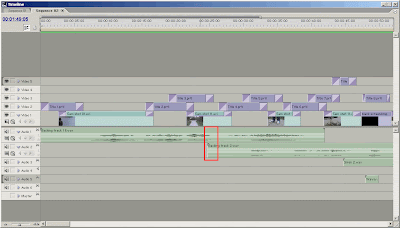
The non-diegetic sounds we used are also a development of this typical convention. Because they are not specific and not directly linked to the footage, they create suspense and engage the audience.
We also aimed to create a sense of isolation. To do this we filmed the protagonist walking down narrow pathways. We also had several shots of the boy walking down long pathways off into the distance, this suggests he doesn't really know where he is going, and gives the impression of being lost and having little purpose. The sense of isolation and desperation are typical convention and I feel we not only used but also developed these conventions.
Most thrillers conventionally use a creepy font for their titles to attract attention. I feel we have developed this convention as our font could suggest life draining away. As well as this, most thrillers have their titles fading in slowly. We also use this convention.
Overall, I feel Luke and I not only used typical conventions of a thriller but also developed them, and as a result made an engaging opening sequence to a thriller.
How does your media product represent particular social groups?
In our opening sequence our aim was to represent vulnerable teenagers. To do this we used a variety of long shots when filming. The long shots are used to establish the character. The boy looks small and isolated in comparison to the large open surroundings which suggests the boy is insignificant. We also filmed the boy from behind. This gives the connotations that he is walking away from something. During the opening sequence we avoid showing the boy’s face. The aim of this is to create suspense for the audience and to emphasise his isolation from society. As the sequence progresses we do however include a single shot showing the boy’s face, this is so the audience can identify with the protagonist.
In the soundtrack the news reporter says “A boy has been reported missing in Attenborough” this suggests that the boy seen walking is the missing child.
The smashed vase heard, suggests an argument which in turn suggests the boy has run away from home. These non-diegetic sounds further emphasise the boy's vulnerablity and his need to escape from his surroundings. Again this suggests the boy’s isolation.
During the editing process, we used the cross-dissolve effect to show the ellipsis of time. An example of this is when the boy walks down the alley way. The ellipsis of time helps to show that the boy is lonely for long lengths of time and emphasises his isolation.

The boy’s costume is dull and not very colourful; again this shows his separation from society. His shoes however are fashionable, this reminds the audience he is a youthful teenager. The bag is used to show he is leaving somewhere which again shows the boy’s isolation. The pathetic fallacy of the grey dull weather is reflective of the boy’s state of mind. In contrast the shots of the woman are brightly coloured despite the woman being dead/injured. This further emphasises the boy’s split from society.
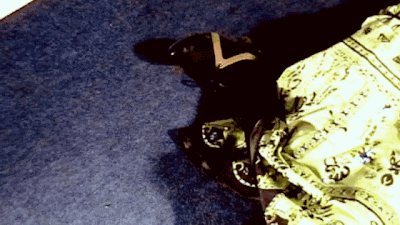
What kind of media institution might distribute your media product and why?
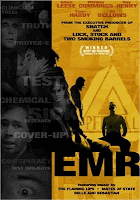 As our opening sequence is potentially quite unnerving, the type of institution to distribute our product would not be a family orientated organisation, because young children would be alarmed by the nature of the thriller. A film distribution company would distribute our film into cinemas. A suitable example would be Dogwoof Pictures. Dogwoof Pictures is a UK film distributor who is probably best known for the release of EMR (James Erskine, Danny McCullough 2004). EMR was the first film worldwide to have a simultaneous release.
As our opening sequence is potentially quite unnerving, the type of institution to distribute our product would not be a family orientated organisation, because young children would be alarmed by the nature of the thriller. A film distribution company would distribute our film into cinemas. A suitable example would be Dogwoof Pictures. Dogwoof Pictures is a UK film distributor who is probably best known for the release of EMR (James Erskine, Danny McCullough 2004). EMR was the first film worldwide to have a simultaneous release.EMR (James Erskine, Danny McCullough 2004) is a physiological thriller distributed by Dogwoof Pictures. It made both critical and fininacial success. Dogwoof Pictures have experience in distributing British Thrillers and so would be suitable for distributing our product.
Who would be the audience for your media product?
Our target audience was primarily 14 - 24 year olds both male and female.

We targeted this audience as research shows 35% of people who watch thrillers are of this age. We wanted our protagonist to be of this age, as then our target audience can relate to some of the things he is feeling, and thereby engage the audience.
However, despite aiming our thriller at a younger audience, the nature of our thriller can appeal to a wide age-range of people and is suitable for anyone who enjoys thrillers.
How did you attract / engage your audience?
In our opening sequence, Luke and I tried to create suspense. We didn't want to give away too much of the story in our first two minutes so instead tried to engage the audience by creating narrative enigmas. We believed that an interesting way to engage the audience was through the use of sound. So in our soundtrack we included various sounds that didn't specifically fit with the footage of the boy walking. Examples of these are the police sirens, the police radio, the news reporter, and the argument. These things are not seen, but merely heard, (non-diegetic sounds). The sounds are also not too specific; we don't reveal too much of what will happen. The aim of this to engage the audience and get them asking questions, such as: "Why are there police sirens?"
To create suspense, when filming, we didn't want to show too much of the protagonist's face, instead we used over the shoulder shots, and long shots.
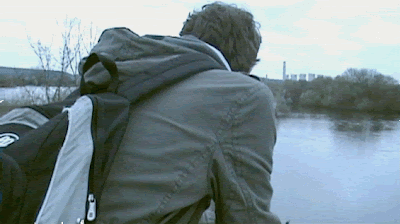
With not showing the audience the boy's face, it keeps the audience interested. They are not sure who he is and how he may be involved in the story. The quick straight cuts of the woman's body also engage the audience. They do not understand how she is involved in the story. Again we also avoid showing her face; this further enhances the feel of mystery. The creation of suspense and mystery engages the audience further as they want to find out what has happened and so continue to watch.
The protagonist in our opening sequence is fairly young. We wanted a young boy because the character is meant to be vulnerable. As well as this it also engages our young target audience as they can easily identify with the boy and his emotions.
From audience feedback I can tell that we successfully engaged our audience during the opening sequence. Examples of feedback were;
"I was engaged by the opening sequence, I wanted to know how the story unravelled, to see whether the boy walking was the victim or the perpetrator."
"The opening sequence did engage me, the way the events did not seem to happen in a chronological order added mystery to the sequence and made me want to see more."
"The opening sequence was suspenseful and mysterious and did engage me. The fact that the boy leaves the bag on the bench intrigues me, I want to find out whether it is significant or not. The background (non-diegetic) sounds also interest me as I want to find out how they fit in with the story."
What have you learnt about technologies from the process of constructing this product?
Both Luke and I have learnt many things whilst filming and editing our opening sequence. Most importantly I have learnt the importance of using a tri-pod and the importance of setting the white balance. I am also now far more confident with using a digital video camera and can quite comfortably operate one again.
During the editing sequence, the major thing I have learnt is how to use the editing suite, Adobe Premier Pro. For example one problem we encountered was that we wanted our opening sequence to be set at night, however when we tried to film at night, the footage was really dark and of a low quality. Instead we filmed during the day and using Adobe Premier Pro we could adjust the light levels to our preference.

To do this, we added the levels effect, and then we could easily adjust each aspect of colour in our footage. We altered several levels which enhanced our footage, the main alteration was the (RGB) Gamma level increased to give us clearer footage.
As well as learning how to adjust the effects on the footage, I have also learnt how to cut the footage down using various methods.
 Examples are setting the in and outpoints, and then dropping it to the time-line or alternatively, using the razor tool to cut the footage where desired. I have a full understanding of using the time-line, I understand the importance of rendering footage (gives the footage a higher quality finish and smoothness) and am confident with most aspects of using Adobe Premier Pro. I am also confident I can quickly learn how to use various other editing programmes as I now understand the foundations of editing footage. I have also revisited Audacity. I used this programme to edit the soundtracks we used and am now confident in using it.
Examples are setting the in and outpoints, and then dropping it to the time-line or alternatively, using the razor tool to cut the footage where desired. I have a full understanding of using the time-line, I understand the importance of rendering footage (gives the footage a higher quality finish and smoothness) and am confident with most aspects of using Adobe Premier Pro. I am also confident I can quickly learn how to use various other editing programmes as I now understand the foundations of editing footage. I have also revisited Audacity. I used this programme to edit the soundtracks we used and am now confident in using it.Finally I learnt how to export and burn our film onto a DVD as we had to do this for draft film which we handed to our teacher for marking.
Looking back at your preliminary task, what do you feel you have learnt in the progression from it to the full product?
Since my preliminary task, I feel I have learnt many new skills, not only just with using a camera and editing software, but also in the planning and research stages. In my preliminary task, little thought went into planning, and very little research was done. However in the Thriller project, I did thorough research into both the industry and into what people wanted to see. This meant we could specifically target our audience.
 Both Luke and I also carefully studied the conventions of a thriller, this set us in good stead, as we knew what we wanted to include in our thriller and what we wanted to achieve. We also planned very carefully in our final project; not only did we make brainstorms and a storyboard, but we also made a time-line of each shot, which we could easily re-order. I think these two stages helped a great deal and were responsible for a high quality opening sequence I feel we produced.
Both Luke and I also carefully studied the conventions of a thriller, this set us in good stead, as we knew what we wanted to include in our thriller and what we wanted to achieve. We also planned very carefully in our final project; not only did we make brainstorms and a storyboard, but we also made a time-line of each shot, which we could easily re-order. I think these two stages helped a great deal and were responsible for a high quality opening sequence I feel we produced.I have also progressed with physically using a camera. Since the preliminary task I have learnt how to pan properly. To film a high quality pan you must pan a whole 180 degree pan, and then in the editing stage crop the footage so you have a pan of your desired length. This way you eliminated a jerky movement. I also now understand the importance of continuity. Previously when filming the preliminary task, we had the curtains closed, and then open. Although we did not film the curtains, it meant the lighting was dramatically different.
To hide this we had to make the film black and white. This meant, however, I was far more cautious when filming the thriller project, and I was always looking out for places where we may have made a continuity error.
Compared to when we edited the preliminary task, I am now much more confident with my editing skills. I know a whole array of short-cuts and am much more comfortable with editing. Both Luke and I edited the footage, and we worked well as a team as we could both see ways of improving our footage. One main alteration we made from our draft edit was changing our aspect ratio from 4:3 to widescreen. We felt this made our opening sequence look more cinematic and professional. We also made sure to set the white balance so the colours were the same in each shot.
When making the preliminary task, we had very limited time, this meant the quality of our filming was poor and the editing was rushed. The lack of time also meant that we didn't have time to review our project and make suitable alterations. However during the thriller project, we had far more time, this meant I could assess our progress and we discussed what needed to be altered. This meant we were always improving our opening sequence.
Overall, I feel as I have progressed since the preliminary task. I now have a far greater understanding of using editing software, a camera, and how to create suspense. Luke and I have worked well together, we have listened to each other and between us, and I feel we have created a high quality opening sequence to a thriller.
Friday 3 April 2009
Progress III
 We also made two seperate sequences. One sequence has our initial draft footage, and the other sequence has our new footage.
We also made two seperate sequences. One sequence has our initial draft footage, and the other sequence has our new footage.To start editing the footage, we dragged a clip into the "input monitor" from the "project tab".
 Here we can set the in and out points, to select the desired footage, and then drop it to the time-lime using the insert tool. With doing this, we only have to work with the relevant footage.
Here we can set the in and out points, to select the desired footage, and then drop it to the time-lime using the insert tool. With doing this, we only have to work with the relevant footage.
We can then edit the footage using tools tab and the effects tools in the project tab. Use the zoom-in and out function located in the bottom left to easily select your footage. Then click and drag the effect onto the footage.
Thursday 2 April 2009
Creating the soundtrack
http://www.soundsnap.com/
http://incompetech.com/m/c/royalty-free/
Here are screen shots of the process we went through when creating our soundtrack:


Progress II

We are also going to use a new actor. Scott Green, our initial actor, is also taking AS Media, and subsequently filming his own thriller. This means he has little time to act in our film. Instead, Sam Bartys will act for us. He is a reliable, available friend, who has experience in drama.
Although we would have prefered our thriller to be set at night, it was not possible for us to film it at night as we do not have sufficient equipment. Instead we tried to adjust the saturation, exposure and various levels of colour in the editing stage, to make our footage darker. However when we burnt our initial draft edit onto disc, the quality of the image dropped greatly. As a result we will re-shoot in daylight, despite our preferences.
Sunday 22 March 2009
Progress
-Drop the exposure 2-4 stops using gain or iris
-Edit the shadow, mids and highlights
-Change white balance from daylight to tungsten
-Add a blue tint
-Desaturate
We also started to create our soundtrack. So far the progress made is substainial and I am happy with what we have achieved. We will continue to work outside of lesson time in order to meet our interim deadline of intial take.
Monday 9 March 2009
Filming Schedule
We will film the remaining shots in Wednesday's lesson and then finish up over the weekend ready to start editing in a weeks time (Monday 16th March)
Monday 2 March 2009
Props for Thriller

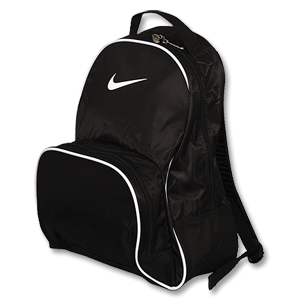
We originally planned on the viewers being able to see the note. However after revisiting the idea we have decided that the audience will only actually see an envelope, or a folder peice of paper. This is because we don't want to give too much away in the opening sequence.
We allready have each prop prepared apart from the broken vase or pot; we found that breaking a vase would be as stated on our risk assessment, dangerous. Instead we have researched into a classic production prop called sugar glass, also known as candy glass. We will produce sugar glass by using a cooking recipe we found on the internet. This is much safer and also suits our small budget.
The instructions for producing our sugar glass is as follows...
Materials :
Old saucepan
Oven
Baking thermometer
2 measures of water
1 measure of golden syrup
3 1/2 measures of sugar
A mould for your glass (depending on the shape requirements)
Steps :
Mix the water, golden syrup and sugar together in the saucepan and bring it to a boil on the oven.
Leave it boiling until the mixture is thick, with almost all the water boiled off.
Pour it into whatever mould you're using and let it cool.
Friday 27 February 2009
Interim deadlines for Thriller
Animatic Storyboard to be completed by the first lesson of the w/c 23rd Feb
Initial Filming to be completed by the first lesson of the w/c 16th March
Initial Editing to be completed by the first lesson of the w/c 23rd March
Final Filming and Re-edit to be completed by the first lesson of the w/c 6th April
Evaluation to be completed by the first lesson of the w/c 20th April
Final Adjustments to be completed by the last lesson of the w/c 27th April
FINAL DEADLINE: THURSDAY 30th APRIL 4PM
Thursday 26 February 2009
Risk Assesment
Numerous risks can be pointed out during the filming of our project, these include:
1) The breaking of our sugarglass
2) Dangers of filming around river
3) Transportation of equipment to further destinations
4) Electric equipment being used outdoor
5) Possibility of it raining
We will ensure our safety and our equipments safety by doing the following things:
1) Break it in a controlled environment with no unnessesary people in the room, we will use safe surroundings that has space, also we will ensure that our broken sugar glass can easily be cleared up.
2) We will film the water sequence with a reasonable distance between us and the water, this will prevent us slipping in or damaging equipment with water.
3) When transporting equipment we will ensure we use the appropriate carriers, for example for the cameras we will use the allocated bag that come with them, when travelling on the bus with equipment we will ensure it’s safety by keeping it at our side.
4) We will ensure all wires are tooked away and any lighting will be switched off when not in use at the mains.
5) We will check the weather forcast before setting out to film and also make sure we have waterproof carriers with us, so we can store the equipment if it does start to rain.
Deciding on actors

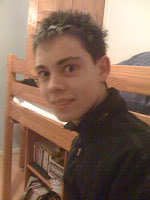

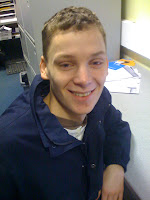
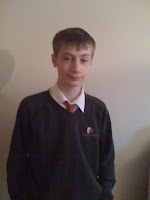

We chose the actor below because he looks relativley vunerable, young and is a reliable friend. Scott also has a GCSE in Drama, so this will be a valuable asset to our sequence. We will work around Scott's availability as to when we film.
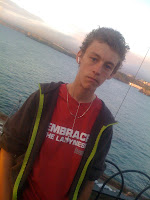
Designing the Costume
Planning and Developing
Monday 23 February 2009
Deciding locations
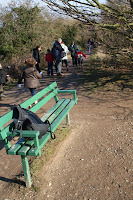
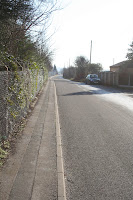
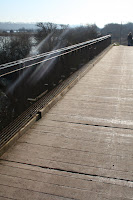

Sunday 22 February 2009
Storyboarding the idea
Further development on idea: Timeline
Further development on idea: Brainstorm
 Using this brainstorm, we will create a time-line. We are going to make little slips of paper, and write each shot on each piece. We can then easily re-arrange the order and this will aid us when making the storyboard.
Using this brainstorm, we will create a time-line. We are going to make little slips of paper, and write each shot on each piece. We can then easily re-arrange the order and this will aid us when making the storyboard.
Tuesday 17 February 2009
Audience Research
Here is our completed questionnaire.
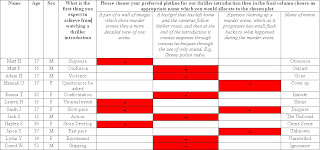
As you can see the most popular idea is the sequence where a child has run away from home, and for this reason we will continue developing only this idea. We now also have many ideas on what people expect to be achieved in an opening sequence. We will consider all these suggestions when further developing and brainstorming our idea. The main convention we need to include is the creation of suspense. Two actors/actress' will be needed in this opening sequence.
I conducted further audience research to get a broader idea of who watches thrillers. We can then target our audience more effieciently. From conducting internet research I found that an equal number of males watched thriller compared to females. This doesn't conform to steryotypes as you would expect more males to watch thrilers, due to the conventions used. Therefore we will try to appeal to both male and female audience.

I also found that the 35% of the people that watch thrillers are aged 14-24; as shown by this graph. We will therefore aim our thriller at this age range.
http://www.valmorgan.com.au/au/audiences/profiles/thrillers/
Research into Thriller genre and industry
In general thrillers rate quite high in the most profitable films. The most famous example being The Blair Witch Project (1999) Daniel Myrick, Eduardo Sanchez. This film had a relatively low budget of approximately $35000 and made a profit that was 7107 times the initial investment reaching a total of $248,660,000 making it the most profitable film of all time. The success of the film was in the production and marketing. The actors were only given a vague description of the plot and therefore acted in such a way that the audience perceived it as a real documentary. This enticed the audience and helped to create narrative enigmas. I also aim to entice my audience using suspense and narrative enigmas.
Thrillers also rate quite high in the top favourited films of all time. The Godfather (1972) Francis Ford Coppola rates second in IMDB Top 250 Movies, and The Godfather, Part II (1974) Francis Ford Coppola rates in third place. The Dark Knight (2008) Christopher Nolan and Star Wars: Episode V - The Empire Strikes Back (1980) Irvin Kershner also rate in the top 10 films.
Sunday 15 February 2009
Detailed Analysis of opening sequence of Thrillers
The Godfather (1972 Francis Ford Coppola)
Whilst the production company is introduced, and the title is shown, traditional Italian non-diegetic music is played. The slow violins create an eerie yet intriguing atmosphere. The title fades to the opening shot. The music stops as the character first speaks. As the character talks about how is beloved daughter was hospitalised in a violent attack, the camera zooms out ever so slowly. At first the audience think he is talking directly to the camera, the room is dark and the background is blurred so we don't realise anyone else is present. As the character becomes upset, the protagonist (the Godfather) comes into shot. At this point we realise there is more than one person in the room, and that the initial character is pleading for help, to get revenge. The revenge theme and the insight to the plot, engage the audience and help to create a narrative enigma.
The dark setting and the early establishment of a revenge theme are typical conventions of a thriller, and the unfamiliar surroundings is also typical of opening sequences in a thriller. I will consider these conventions when planning the opening sequence of my own Thriller.
The Godfather: Part II (1974 Francis Ford Coppola)
The sequel to the original film starts very much the same as the first, in a dark unclear environment. The section is accompanied by a similar eerie non-diegetic tune. It then however cuts to an extreme long shot of an outdoor scene where people begin to cross a desert-like environment. This scene is accompanied by a different tune, which is not as eerie, yet however has a sad feel to it. Text is displayed on top of the shot, and explains how the protagonist's father was murdered by the local Mafia and how is brother had sworn revenge on the murderers and disappeared into the hills. As the text fades, we cut to a closer shot and realise that this is the funeral of the late father.
Gun shots are heard and the characters disperse, it is quickly revealed that brother that swore revenge, was shot by the Mafia. Again this creates narrative enigmas and keeps the audience interested. It also derives sympathy for the mother and protagonist.
The theme of revenge also occurs in the opening sequence, just like it did in the previous film. Questions are quickly raised, and these keep the audience interested. I also aim to raise questions and create suspense in my opening sequence to keep the audiences interest.
Lucky Number Slevin (2006 Paul McGuigan)
As the camera pans across a notepad, the names of the director and actors etc appear. Non-diegetic eerie harp music accompanies the sequence. As well as this other noises can be heard. We can hear what sounds like a sports commentator uttering numbers of the players, police sirens, a news report on a shooting, police radios and other various day-to-day sounds. The notepad shot then fades to a medium shot of what appears to be a Hotel room, a telephone is the focus of the shot, however the shot quickly fades to an unusual shot of a lift and then this shot dissolves to a medium shot of a man walking through a multi-storey car park to his car. As the man is about to unlock his car door he is shot twice with a silenced gun. The killer then picks up the victim's folder and walks away. Suspense is built because we never see the killers face. The silenced gun implies that the killer is stealthy and that the man was targeted specifically. The shot then cuts to the notepad again and then to another scene where the killer commits murder again, and again takes the victim's folder. Just like the first murder, it is stealth like and we don't see the killers face. This further derives suspense and engages the audience.
Tuesday 10 February 2009
Brainstorming ideas
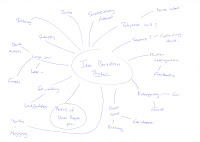 To start our project going, Luke and I decided we would brainstorm lots of initial ideas on what our Thriller could be like. To do this we made a mind map.
To start our project going, Luke and I decided we would brainstorm lots of initial ideas on what our Thriller could be like. To do this we made a mind map.Once finished we had an idea on what we wanted to do. We then began to think about how we could
 include typical conventions to further our ideas. We selected three of our ideas and thought about them in more detail. We also constructed a questionnaire asking other people's opinion and what they thought of our initial ideas. We will carry out this questionnaire next lesson. Below is another mind map we made where we jotted down our further ideas. Next lesson we will focus our attention on audience research and research into Thrillers.
include typical conventions to further our ideas. We selected three of our ideas and thought about them in more detail. We also constructed a questionnaire asking other people's opinion and what they thought of our initial ideas. We will carry out this questionnaire next lesson. Below is another mind map we made where we jotted down our further ideas. Next lesson we will focus our attention on audience research and research into Thrillers.
Monday 9 February 2009
Group decided
Conventions of a Thriller
Camera angle and Movement Conventions:
- Quick cuts and camera angle changes
- Pans of dark environments
Editing Conventions:
- Quick fast paced cuts during action scenes
- Use of negative editing to derrive suspense
Mise en Scene Conventions:
- Use of shadow
- Mirrors which shows the antagonist's reflection
- Spiral Staircases
- Dark Lighting
- Costume reflects victim's state. Torn clothes etc.
Sound Conventions:
- Sudden eerie chimes to create suspense
- Eerie echos
- Exaggerated sounds, e.g. loud footsteps
Other Conventions of a Thriller:
- Crime is often the narrative
- There is often a theme of identity
- Protagonist with a flaw which is exploited by the antagonist
- Complex narrative
- Usually many plots within one main narrative
- Sympathy is derrived for the victim
Wednesday 4 February 2009
Research: Analysis on Thrillers
I watched the opening sequence to two Thrillers; The Others (2001 Alejandro Amenabar), and Memento (2000 Christopher Nolan). The Others, is a story about a mother (Nicole Kidman) and her two children set in a large creepy mansion. Strange things start to happen in the house, when the maids and cook etc disappear. The children then start to see ghosts. But are they ghosts? Memento is about Leonard (Guy Pearce) seeking revenge on the man who murdered his wife. The twist however is Leonard can’t remember any new memories after 15 minutes, his only memories are those previous and including the night his wife died. Both films include typical conventions of a thriller, below are the conventions I found in both opening sequences.
The Others:
- Low naturalistic lighting creates gives the mansion a dominant scary feeling.
- Lots of Shadow, makes the setting seem creepy. (In the film, the two children are allergic to excessive light, this is another reason for the dim settings)
- Quick camera angle changes derives sense of panic
- Quick cuts derive sense of panic
- Creepy non-dietetic chimes make you jump and help you to understand the characters state of panic
- Fast paced music engineered to create panic
Memento:
Chronological work - the order of events are mixed up in order to keep you thinking.
Use of Flashback – keeps the viewer thinking and derives suspense
Features a typical “hard” man, whom is familiar to danger
Low naturalistic light derives eerie feeling
Use of black and white – distinguish different time periods and also derives eerie feeling and suspense
Sudden non-diegetic chimes create suspense
Violent resolution to film – Typical convention of a physiological thriller
Preliminary Task: Analysis and Critique
Preliminary Task: Editing
We were shown how to use the program and some top techniques before we edited our own sequence.
There are four main windows in Adobe Premiere Pro used for editing. These are the Project Browser, the Preview box, the Timeline, and the Toolbar. We were shown how to use each window and the main tools, including capturing footage, setting in-points and out-points and editing using the Timeline. We also learnt how to use add titles, and video effects/transistions.
We each had a go at editing our sequence so that we each got practice at doing it. It took us little over an hour to do so, and we are all please with our final film. There are however somethings we can improve on when making our thriller. Please see Preliminary tasks: Analysis and Critique, to read the analysis.
Preliminary Task: Filming
Before filming we were taught certain techniques on how to film efficiently. Below are the key points.
- Treat the cameras with respect in order to avoid damage
- Use a cloth to clean the lens
- Use a tri-pod to film in order to keep the camera steady
- Turn off steady-shot mode
- Set the audio level to 16-bit not 12-bit
- Use pre-roll and post-roll techniques to make sure all the footage is captured. (This can be later cropped in the editing stage)
- Don't point the lens at the sun
- Keep the action in the centre of the screen
- Set white balance
- Adjust zoom to alter focus
White balance: Before filming, hold a piece of paper where you intend to act. Set the camera to white balance, and zoom in on the paper and press "OK". Do this to let the camera know what is actually white in the area you are filming, from this it can adjust all the surrounding colours to their natural colour.
Filming was a success. It took approximately 45mins to film our 30 second piece. There were no particular obstacles to overcome, and we filmed what was planned in our storyboard.
Preliminary Task: Storyboard
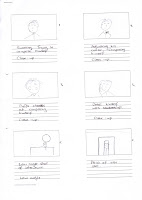
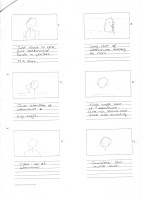
 We then made a storyboard and planned out each shot in detail. Not only did we do this for organization, but it also helped us to think about what type of shot we needed, and this enabled us to think about what effect each angle/movement had on the audience. It also helped us to understand the 180 degree rule and how to avoid this problem when filming.
We then made a storyboard and planned out each shot in detail. Not only did we do this for organization, but it also helped us to think about what type of shot we needed, and this enabled us to think about what effect each angle/movement had on the audience. It also helped us to understand the 180 degree rule and how to avoid this problem when filming.
Preliminary Task: Costume
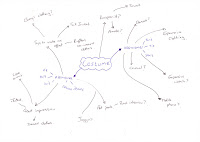 The next stage was to think about possible costumes. To do this we made another brainstorm.
The next stage was to think about possible costumes. To do this we made another brainstorm.After considering many ideas, we decided that the interviewer would be dressed smartly and the interviewee tries to make an effort to look smart, however has improperly ironed clothes and is more smart-casual. We chose these costumes to give the audience an indication of the personality of the characters.
Preliminary Task: Location and Props
Preliminary Task: Brainstorm
The Preliminary Task
My group consisted of Sam Gibbons, Holly Costema, Ryan Boyington, and myself.
We started by brainstorming ideas for our 30 second sequence. Above is our brainstorm.













